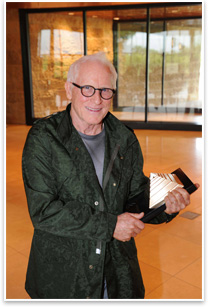 Diversity Diversity
Predock Brings Accessibility to Milwaukee School
Gold Medalist receives 2008 Paralyzed Veterans of America 2008 Barrier Free America Award
by Douglas E. Gordon, Hon. AIA
Executive Editor
Summary: The Milwaukee Indian Community School, designed by AIA Gold Medalist Antoine Predock, FAIA, with architect of record eppstein uhen : architects, received the Paralyzed Veterans of America (PVA) 2008 Barrier Free America Award in July. Located on a rolling, wooded site, the building accommodates many floor-level changes with total wheelchair accessibility. The PVA Barrier Free America Award honors and promotes leadership, innovation, and action in the architectural and design communities in advancing accessibility.
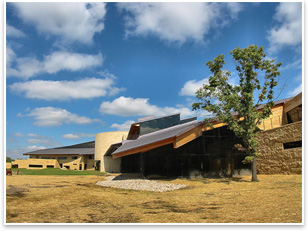 “Accessibility is part of the site specificity of this building,” Predock says. “The building adapts to the site, rolls with the site, flows with the site, ramps where it needs to ramp, with an elevator where you need to get to another level in a central location so everybody has a shared experience going vertically.” “Accessibility is part of the site specificity of this building,” Predock says. “The building adapts to the site, rolls with the site, flows with the site, ramps where it needs to ramp, with an elevator where you need to get to another level in a central location so everybody has a shared experience going vertically.”
“When we started with the design of the school, we didn't even think about whether it should be accessible or what the law was,” said Mark Denning, a member of the school’s board of directors. “We knew what the law was, and we needed to do more.”
“Accessibility was part of the process and not isolated as a separate subject,” Predock agreed. “But I'm so honored that it's been seen that way.”
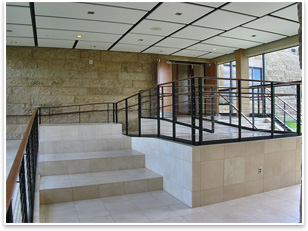 The Milwaukee Indian Community School is a privately owned and operated urban intertribal school educating American Indian children from kindergarten through the eighth grade. Created three decades ago as a reaction to what local tribal members considered inadequate public schools, the school’s curriculum focuses on seven core values: bravery, love, truth, wisdom, humility, loyalty, and respect. Beyond academics, the students learn American Indian spirituality, languages, ceremonies, cultural identity, and pride. With more than 300 students and 95 staff, the school body currently includes members of 12 Indian tribes, predominately the Ojibwe, Oneida, and Menominee. The Milwaukee Indian Community School is a privately owned and operated urban intertribal school educating American Indian children from kindergarten through the eighth grade. Created three decades ago as a reaction to what local tribal members considered inadequate public schools, the school’s curriculum focuses on seven core values: bravery, love, truth, wisdom, humility, loyalty, and respect. Beyond academics, the students learn American Indian spirituality, languages, ceremonies, cultural identity, and pride. With more than 300 students and 95 staff, the school body currently includes members of 12 Indian tribes, predominately the Ojibwe, Oneida, and Menominee.
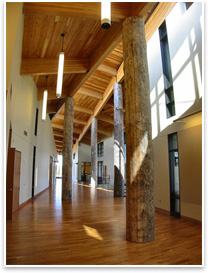 “All-access is good for all people, and the Indian Community School of Milwaukee is an inspiring example of this principle in practice,” said Paralyzed Veterans’ National President Randy L. Pleva Sr. “Through their hard work, architects and their clients can play an extremely important role in removing the barriers that people with disabilities face everywhere, everyday—an advance that improves everyone’s quality of life. “All-access is good for all people, and the Indian Community School of Milwaukee is an inspiring example of this principle in practice,” said Paralyzed Veterans’ National President Randy L. Pleva Sr. “Through their hard work, architects and their clients can play an extremely important role in removing the barriers that people with disabilities face everywhere, everyday—an advance that improves everyone’s quality of life.
“Encourage the architects and designers in your community to imagine how a person with disabilities will experience the buildings and spaces they have in mind,” Pleva advises. “This heightened sense of awareness and empathy will not only improve the quality of buildings and spaces for people with disabilities, but for everyone.”
Connections to nature
“Accessible connections to outdoor spaces are available throughout the facility, at all levels,” says PVA Architecture Director Carol Peredo Lopez, AIA. “Classes use these areas for reading and viewing the wildlife that inhabits the 130-acre property. One thing that struck us about the facility is that every part of the building is accessible at every floor level. The many floor changes are all seamlessly integrated in an accessible manor. And the space is flooded with daylight.”
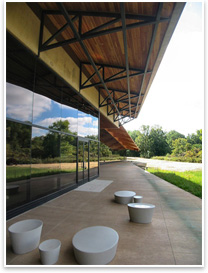 A central circular “drum space” is accessible by a ramp that arches outside the drum. The space opens to a main reception area with a sliding copper semicircular wall. “Copper contains our children and also our water,” Denning explains of the Great Lakes tribal veneration for the metal so important to their ancestors’ Copper Culture. A central circular “drum space” is accessible by a ramp that arches outside the drum. The space opens to a main reception area with a sliding copper semicircular wall. “Copper contains our children and also our water,” Denning explains of the Great Lakes tribal veneration for the metal so important to their ancestors’ Copper Culture.
On the second level, hollowed trees cover the steel structural columns. These trees, donated by the Menominee, were taken from that tribe’s old-growth forest holdings and represent one more symbol of the heritage the building conveys to its students. “Before we, as individuals, were even imagined, our ancestors were preparing this world for us,” Denning said. “This school, hopefully, is a way for us to set an example for the next seven generations after we are gone.” |



 “Accessibility is part of the site specificity of this building,” Predock says. “The building adapts to the site, rolls with the site, flows with the site, ramps where it needs to ramp, with an elevator where you need to get to another level in a central location so everybody has a shared experience going vertically.”
“Accessibility is part of the site specificity of this building,” Predock says. “The building adapts to the site, rolls with the site, flows with the site, ramps where it needs to ramp, with an elevator where you need to get to another level in a central location so everybody has a shared experience going vertically.” The Milwaukee Indian Community School is a privately owned and operated urban intertribal school educating American Indian children from kindergarten through the eighth grade. Created three decades ago as a reaction to what local tribal members considered inadequate public schools, the school’s curriculum focuses on seven core values: bravery, love, truth, wisdom, humility, loyalty, and respect. Beyond academics, the students learn American Indian spirituality, languages, ceremonies, cultural identity, and pride. With more than 300 students and 95 staff, the school body currently includes members of 12 Indian tribes, predominately the Ojibwe, Oneida, and Menominee.
The Milwaukee Indian Community School is a privately owned and operated urban intertribal school educating American Indian children from kindergarten through the eighth grade. Created three decades ago as a reaction to what local tribal members considered inadequate public schools, the school’s curriculum focuses on seven core values: bravery, love, truth, wisdom, humility, loyalty, and respect. Beyond academics, the students learn American Indian spirituality, languages, ceremonies, cultural identity, and pride. With more than 300 students and 95 staff, the school body currently includes members of 12 Indian tribes, predominately the Ojibwe, Oneida, and Menominee. “All-access is good for all people, and the Indian Community School of Milwaukee is an inspiring example of this principle in practice,” said Paralyzed Veterans’ National President Randy L. Pleva Sr. “Through their hard work, architects and their clients can play an extremely important role in removing the barriers that people with disabilities face everywhere, everyday—an advance that improves everyone’s quality of life.
“All-access is good for all people, and the Indian Community School of Milwaukee is an inspiring example of this principle in practice,” said Paralyzed Veterans’ National President Randy L. Pleva Sr. “Through their hard work, architects and their clients can play an extremely important role in removing the barriers that people with disabilities face everywhere, everyday—an advance that improves everyone’s quality of life. A central circular “drum space” is accessible by a ramp that arches outside the drum. The space opens to a main reception area with a sliding copper semicircular wall. “Copper contains our children and also our water,” Denning explains of the Great Lakes tribal veneration for the metal so important to their ancestors’ Copper Culture.
A central circular “drum space” is accessible by a ramp that arches outside the drum. The space opens to a main reception area with a sliding copper semicircular wall. “Copper contains our children and also our water,” Denning explains of the Great Lakes tribal veneration for the metal so important to their ancestors’ Copper Culture.